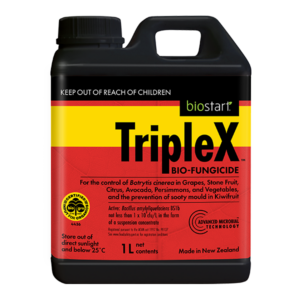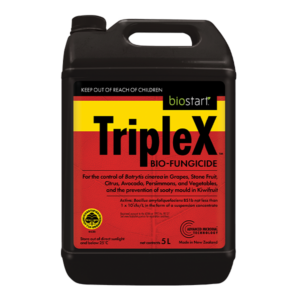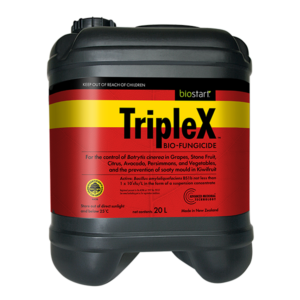TripleX
Organic biocontrol agent for Botrytis, Sooty Mould and Sclerotinia
Buy now
Fungal diseases can destroy a crop or reduce the fruit or vegetable’s marketability. Covering the foliage with protective microbes early in the season, enables plants to resist fungal diseases.
TripleX is a biocontrol agent that treats botrytis (Botrytis cinerea) in grapes, avocado, top fruit and vegetables and prevents sooty mould (Cladosporium species) and sclerotinia in kiwifruit.
TripleX contains two methods of control:
- The microbe Bacillus amyloliquefaciens BS 1b populates the leaf and controls Botrytis and prevents sooty mould – it produces a wide range of antimicrobial compounds that destroy the disease and reduces re-infection
- Fermentation extracts and other bioactive nutrients help to prime the plants leaf biofilm – creating an ideal environment for the establishment of the amyloliquefaciens.
Like all biocontrol agents, use TripleX as a preventative for best results. Apply early so that the protective microbes have time to completely colonise the foliage, flowers and fruit areas where the disease-causing fungi like to grow. In times of rapid plant growth or fruit development, re-apply TripleX to cover new plant surfaces.
Reduce the risk of fungicide resistance by using TripleX as part of an IPM strategy.
Key features of TripleX include:
- Triplex is certified organic
- TripleX is Registered pursuant to the ACVM act 1997 No P8137
- TripleX is tested to be free of amino alcohols and quaternary ammonium compounds (DDAC)
- TripleX leaves no deposits on the crop and there is zero withholding time on most crops
- TripleX is compatible with many commonly used fungicides and insecticides allowing it to be co-applied with these products.
TripleX is listed on the New Zealand Winegrowers Spray Schedule and the Zespri Crop Protection Standard.
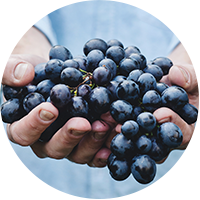 |
Botrytis control Find out how TripleX can help Read more |
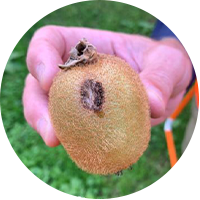 |
Control Sclerotinia over flowering Independent trials were conducted over three seasons (2018/19, 2019/20 and 2021/22) in six Bay of Plenty Hayward Orchards. TripleX reduced the incidence of Sclerotinia by 45%… Read more |
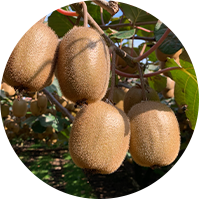 |
Use TripleX to prevent sooty mould TripleX trial results from the Bay of Plenty in 2016. TripleX reduced the incidence of sooty mould in both Hayward and G3 crops in Te Puke and Opotiki. Read more |
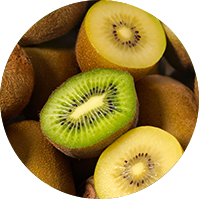 |
Kiwifruit Trial Sheet The Biostart Kiwifruit Programme was undertaken in two Bay of Plenty Hayward kiwifruit orchards by Seeka managers from 2020–2022, resulting increased yield and reduced rejects, while fruit size and quality is maintained. Read more |
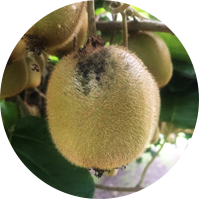 |
TripleX Sooty Mould Case Study An overview of trial work by Dr Jerome Demmer, 5 March 2014. Read more |
 |
The Alexander Family Farm – Testimonial The Alexander Farm grows kiwifruit and uses Mycorrcin and Foliacin to create a more self-sustaining habitat, to be kinder to the environment and save money. Read more |
Crop specific information
| Crop | Timing | Application rate |
|---|---|---|
| Grapes Botrytis | Flowering 5% and 80% cap fall (E-L 20 and 25) | Spray at bunch line at a dilution rate of 500 mL/100 L water. |
| Grapes Botrytis | Pre bunch closure (E-L 31–32) | Spray at bunch line at a dilution rate of 500 mL/100 L water. |
| Grapes Botrytis | Late season (E-L 35–38) | Spray at bunch line fortnightly at a dilution rate of 500 mL/100 L water. |
| Stone Fruit, Citrus, Avocado and Persimmons Botrytis | Prior to periods of disease pressure | Spray fortnightly on to fruit and foliage at a dilution rate of 500 mL/100 L water. |
| Vegetables | Prior to periods of disease pressure | Apply 1.5 L/ha. Spray fortnightly. |
| Kiwifruit sooty mould prevention | Early January to late March when passion vine hoppers (PVH) and cicadas are active | Spray at 2-3 week intervals on to fruit and foliage at a dilution rate of 300 mL/100 L water. To ensure good fruit coverage, add an approved super wetter at the recommended label rate and adjust application rates accordingly (call 0800 116 229 if uncertain of compatibility). |
| Hayward kiwifruit Sclerotinia control | At 80–90% flowering, outside of bee foraging times | Apply to the flowers and foliage at a dilution of 150 mL/100L of water to the point of run off. To ensure good coverage, apply with an approved super wetter/spreader at the recommended label rate. |
If your crop isn’t included above, please contact your local BioStart representative for personalised information.
Directions for use:
- Ensure good spray coverage for optimum disease control. Sprayers should be calibrated before use. For best results spray early morning, early evening or in overcast conditions. Do not apply if heavy rain is forecast within the next 24 hrs. Triplex has limited efficacy if daytime temperatures do not reach 18 °C.
- Biostart Organic TripleX can be applied with most cover and nutritional sprays. Some spreaders may reduce efficacy. An extensive chemical compatibility list is available below. If the product you would like to co-apply is not listed, please contact your local BioStart Territory Manager.
- Organic TripleX contains living microbes. The spray tank must be thoroughly cleaned prior to use, to remove any chemical residues that could be toxic to the BS1b microbe. Sanitise spray tank before application to remove any contaminating microbes. Partially fill the spray tank with clean water and start agitation. Maintain a spray solution pH between 5.0 and 7.5 or efficacy may be affected. Add the required amount of Organic TripleX to the tank. Complete filling. Apply diluted product within 8 hours of mixing. Store Organic TripleX below 25°C and out of direct sunlight.
- Sooty mould prevention: Use TripleX in conjunction with approved insecticidal sprays to reduce numbers of PVH and cicadas in the orchard and boundary areas. Regularly monitor PVH nymphs in nearby hedges during December prior to the adults emerging in late December/early January.
- Knowing when infections can start is key to applying TripleX preventatively.
- Hang fly strips in your orchard to help with orchard monitoring.
- Treat hedging with insecticides prior to season commencing to get ahead of the problem. Continue to reduce the number of PVH and cicada in the orchard and surrounding boundary plantings with applications of appropriate insecticides throughout the season. The fewer insects the lower the disease pressure.
Apply TripleX with a super-wetter, spreader (e.g. Duwett) for best all-over fruit coverage. A lot of the insect feeding damage occurs around the stalk of the fruit and a good spreader sticker will ensure that TripleX gets on to the honeydew residues in this area of the fruit. If rainfall is imminent consider using rain-fast spreader sticker (Duwett Rainmaster) that will ensure product stays on the fruit or be prepared to re-apply - Apply TripleX early in the morning or late in the day when the impact of UV on the active microbe in TripleX is minimal.
- Apply TripleX regularly until the PVH and cicada population numbers decrease when the weather cools at the end of March.
- Minimise vine stress – if your canopy looks stressed carry out a leaf nutrient test and correct any mineral deficiencies.
- Botrytis control: Integrate Organic TripleX into an overall disease management strategy whenever fungicide use is necessary. Follow practices known to reduce disease development which may include rotating and/or tank-mixing with other products with different modes of action.
- Sclerotinia control: spray with a good wetter/spreader once at flowering.
Material Safety Data Sheet
Download the material safety data sheet.
Label information
Download the TripleX product label.
Compatibility
View our handy compatibility sheet here.
Mixing instructions
INVERT CONTAINER AND SHAKE WELL. This product contains living microbes. Prior to use, the spray tank must be thoroughly cleaned to remove any chemical residues that could be toxic to the Bs1b microbe. Sanitise spray tank before application to remove any contaminating microbes. Partially fill the spray tank with clean water and start agitation. Maintain a spray solution pH between 5.0 and 7.5 or efficacy may be affected. Add the required amount of TripleX to the tank. Rinse measuring vessel with water and add to the tank. Complete filling. Use a slow agitation rate to mix. Maintain agitation during use and do not leave the spray mixture standing. Apply diluted product within 8 hours of mixing. Maximum spray pressure 20 bar or 300 psi.
Handling precautions
When mixing or applying, avoid contact with skin and eyes. Wear protective clothing, gloves and goggles. Flush applicator thoroughly with water after use. Do not eat or drink while using. Wash hands and face before meals and after work. Wash protective clothing after use.
Storage instructions
Store below 25°C. Keep out of reach of children. Keep container tightly closed. Do not store diluted product.
Withholding period
Nil.
Empty container disposal
Triple rinse and return to an approved AgRecovery recycling centre.

Label information
Download the TripleX product label.
Compatibility
View our handy compatibility sheet here.
Empty container disposal
Triple rinse and return to an approved AgRecovery recycling centre.



